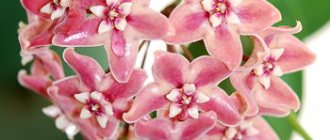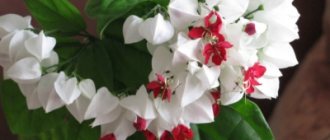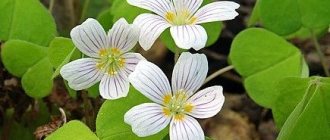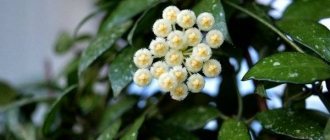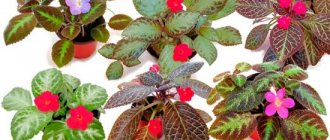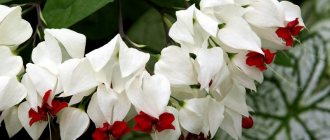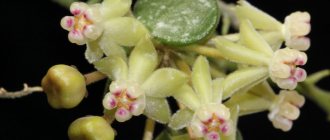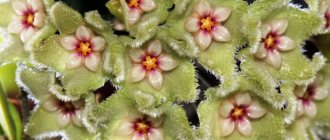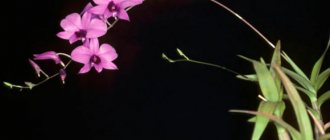Author: Elena N. https://floristics.info/ru/index.php?option=com_contact&view=contact&id=19 Category: Houseplants Published: January 20, 2019Last edits: October 16, 2021
- Growing from seeds
- Insect pests
- Fleshy Hoya (Hoya carnosa), or waxy Hoya
plant (lat. Hoya) , or, as we call it, wax ivy , belongs to the genus of evergreen shrubs and vines of the subfamily Lastovnevye, family Kutrovye. More than two hundred species of hoya grow in the tropics of South and Southeast Asia, Polynesia and the west coast of Australia. Hoya liana prefers open forests, in which it finds a tree for support, or rocky slopes. The Hoya flower was named by the famous Scottish scientist Brown, the author of the theory of “Brownian movement”, in honor of his fellow English gardener Thomas Hoy, who devoted his life to growing tropical plants in the greenhouses of the Duke of Northumberland.
Planting and caring for hoya
- Flowering: in spring and summer, sometimes again in autumn.
- Lighting and watering: for species with succulent leaves - bright sunlight and moistening the substrate after the top layer of soil has dried; for varieties with light green pubescent foliage - bright sunlight and frequent watering; for species with thin leaves - bright, diffused light and frequent watering; for plants with dark green pubescent leaves - shade and frequent watering.
- Temperature: 17-25 ˚C in summer, 10-15 ˚C in winter.
- Air humidity: for species with succulent and pubescent leaves, this indicator is not important, but it is advisable to spray thin-leaved plants in extreme heat.
- Fertilizing: If you regularly change the substrate, fertilizing is not necessary, but if necessary, apply fertilizers for succulent plants.
- Rest period: not clearly expressed.
- Replanting: young plants - annually, adults - once every three years, if necessary.
- Reproduction: seeds and cuttings.
- Pests: aphids, scale insects, red spider mites, whiteflies and nematodes.
- Diseases: root rot, powdery mildew and gray mold.
- Properties: The aroma of hoya flowers can cause headaches.
Read more about growing hoya below.
Where to put according to Feng Shui
The vine-like flower gently spreads vibes and can effectively push a person to positive emotions and calm.
Hoya flower signs and superstitions
You can place the pot in any part of the house, but the teachings of Feng Shui recommend placing the plant in the hallway, in close proximity to the front door - this will help minimize the consequences of the negative attitude of the guests entering and protect yourself as much as possible.
It is believed that Hoya:
- improves worldview;
- adjusts the aura of the room for productive life;
- harmonizes the atmosphere of the home;
- brings the sexual and psychological state of a married couple to a new level;
- has a beneficial effect on mutual understanding between close and distant relatives.
To harmonize the relationship between husband and wife and improve life together, it is better to place the flower in the bedroom. Moreover, preference should be given to the Kerry variety with heart-shaped leaves.
If you place it near the children's room, this will allow the child to quickly learn independence. In the living room - it will help the owners gain strength after a hard day at work.
If you need to establish contact with colleagues and win over your superiors, a pot with a plant is placed within the walls of the office.
Botanical description
In nature, an adult plant can reach 10 meters in length. Leafless young shoots have a violet-brown tint, but as they grow older, when leaves and aerial roots begin to appear on them, the shoots turn green and become woody over time. Fleshy and shiny at a young age, the leaves gradually become dull; they are oval in shape and pointed towards the top. The leaf size is 5-8 cm in length and 3-5 cm in width. Hoya flowers, white or pinkish, bisexual, star-shaped, are collected in umbrellas located on stem branches. The diameter of each flower is 1-2 cm, except for the flowers of Hoya imperialis, which reach 8 cm in diameter. In the center of the corolla of the flower there is a five-membered crown, rising above the petals. The flowers are fragrant and produce nectar that attracts insects.
In culture, hoya can bloom only in brightly lit windows; in addition, the plant has become so domesticated that it no longer needs to be in the fresh air even in the warm season. Indoor hoya is divided into three categories:
- ampelous hoya, or hanging;
- hoya ivy wrapping around the support;
- erect hoya forming a bush.
Hoya description
Hoya is an evergreen plant of the palm family, brought from the tropics and having the appearance of a vine or subshrub. It got its name thanks to the Englishman Thomas Hoy, who worked as a gardener in the greenhouses of the Duke of Northumberland; it was he who was the first in Europe to master the care of wax ivy. The Hoya genus includes many species that differ in color, location and general appearance.
They are united by the following features:
- fast growth;
- green, shiny and fleshy leaves, oval-shaped or with pointed tips;
- woody shoots on which aerial roots appear;
- strong aroma of flowers;
- flowers are bisexual, collected in inflorescences-umbrellas.
Hoya wax ivy is currently a fairly popular species for indoor floriculture. This fast growing vine can reach a stem length of 10 meters. While the vines are young, they can be given any shape due to their flexibility, but after lignification this will be problematic. The appearance of Hoya is very impressive: its shoots are brown-violet in color with dense green leaves of beautiful shapes. The flowers, shaped like openwork stars with a crown, are arranged in groups on umbellate inflorescences, and come in shades of white, pink and yellow. When flowering, Hoya emits a strong aroma and produces nectar.
Caring for Hoya at home
Growing conditions
Different types of hoya are grown in culture, and each requires fulfillment of its own conditions of maintenance, so it is difficult to give general recommendations for all types. The only wish common to all plants of the Hoya genus is to avoid overmoistening the soil, as a result of which liquid mud forms in the roots.
- Catharanthus: growing from seeds, types and varieties
For convenience, we divide hoyas into categories according to the amount of moisture consumed and the required level of lighting:
- Indoor Hoya flower with hard succulent leaves (Hoya fleshy, Hoya Kerry). The optimal location is on a south window, under the rays of the sun. Watering is carried out after the top layer of the substrate has dried. An exception is southern hoya (Hoya australis), which needs constantly moist (but not wet!) soil.
- Types and varieties of hoya with thin leaves (Hoya multiflorum) require constant moisture in the earthen ball and shading from direct sunlight; the ideal place for them is an eastern or western window, and they will do well on a northern window.
- The Hoya houseplant with light green, hairy leaves (Hoya lineara) grows best in full sun and requires regular watering without drying out the clump.
- Hoyas with dark green pubescent leaves (Hoya Thompson, Hoya serpentine) love shady coolness and regular watering without drying out the earthen ball.
As for the comfortable temperature for Hoya, in summer it is 17-25 ºC, and in winter - not lower than 10 ºC, although it would be better a little higher - about 15 ºC. The exception is the beautiful hoya (Hoya bella), which loses its leaves from the cold.
At home, Hoya does not have a pronounced dormant period, but if you notice that the plant has slowed down, reduce watering and stop feeding - let the Hoya rest. Hoya usually stops growing when the daylight hours become short, but if you decide on additional lighting for the plant, the hoya may skip the dormant period.
Fertilizer
In nature, different types of hoya grow in different places, in different soils, and therefore need different types of fertilizers. But according to many observations, the results of which have been published, it is best to feed hoyas with fertilizers for flowering succulents - all species respond well to them. And if you regularly replant the hoya into fresh substrate, then you don’t have to resort to fertilizing at all.
Transfer
Young plants are replanted annually in the spring, and adults - once every three years, if necessary. Hoya does not need a large pot, but buy a new pot for replanting every time - the one left over from some other plant is not suitable. And even a new pot, before transplanting the hoya into it, must be thoroughly washed with ordinary soap, and the substrate must be sterilized.
The soil for hoya needs to be breathable, neutral or slightly acidic, preferably of the following composition: one part of humus and leaf soil and two parts of clay-turf, but many grow hoya in an orchid substrate and even just in garden soil - it all depends on the type of hoya, so approach plant replanting creatively, having first studied the conditions and soil in which your Hoya grows in the wild. A layer of drainage is placed at the bottom of the pot, and the plant is transferred to a new pot along with a lump of earth.
Hoya in different seasons
This plant blooms even in winter. If you want to create such beauty for yourself, then you need to prepare the flower for this in September. To do this, place the container with the plant on the east side.
At the beginning of winter, the flower is watered very little, and as a result, flowers appear on the plant. The most ideal temperature for this period of time is 15 degrees Celsius.
There are also types of hoya that do not like coolness; these include multiflora. If the temperature is below 20 degrees, then it loses leaves and flowers.
As a rule, winter is an opportunity for Hoya to rest, and at this time it is better to water and fertilize it less. It blooms in the warmest times of the year, just when it needs constant care. And all this time the flower needs light.
Hoya propagation
Growing from seeds
How to propagate hoya if you happen to be the owner of a rare treasure - hoya seeds? Ripe and well-dried hoya seeds in the year of their collection are sown in a loose substrate consisting of an earthen mixture and chopped sphagnum moss. The seeds germinate within a week, and as soon as the shoots appear, you must ensure that the soil in the crops never dries out and at the same time is not wet. Keep the bowl with seedlings in a warm, bright place.
- Yucca
To prevent fungal diseases, spray the seedlings with Bordeaux mixture or any other copper-containing preparation in strict accordance with the instructions. After 90 days, when the seedlings produce several pairs of leaves, they are planted in personal pots. However, growing hoya from seeds is made difficult by the fact that seed material cannot be found on sale, and it is almost impossible to obtain seeds from hoya growing at home.
Propagation by cuttings
This is the easiest and most reliable way to get a new plant, since Hoya cuttings take root easily. The stalk should be short, but have at least two nodes and one or two pairs of leaves. You can root cuttings in water or in a substrate. To root in water, wrap the container with foil on all sides, making holes for the cuttings. Leave only the top pair of leaves on the cuttings, treat the lower sections with rooting hormone and push the cuttings through the holes in the foil to such a depth that the lower node is in the water.
The temperature for rooting should not be higher than 22 ºC, but high air humidity is also important for this process, otherwise the cuttings will simply wither. To increase air humidity, place a transparent plastic bag over the container with cuttings, but do not block the air access underneath it. Hoya rooting occurs after two weeks, and it is important to transplant the cuttings to a permanent place at an early stage of root formation, otherwise the cuttings become fragile and break.
How can you root Hoya directly in the substrate? The soil for rooting must have such permeability that excess water can easily flow through it. Before planting, treat the lower cut of the cuttings with root. Sterilize the substrate and pot, place the cutting in the soil to such a depth that the bottom node is in the soil. If the air humidity in the room is low, place a transparent bag loosely over the pot with cuttings. After 2-3 weeks, signs of new growth should appear. If you received cuttings for rooting in the mail and it seems to you that they are too dry, soak them for several hours in slightly sweet water and they will restore their moisture.
Is wax ivy harmful to health?
Regarding human health, prejudices towards hoya can be reduced to two categories:
- the plant brings illness into the house;
- If you fall asleep in a room with waxweed in bloom, you can die.
Flower bed design. TOP 10 simple and effective techniques
Scientists have established that there are no toxic substances in the foliage, stems, roots and flowers. It will not be possible to suffer serious damage to your health while sleeping in a room with hoya - the aroma of the flowers is absolutely harmless, unlike lilies. These flowers actually absorb oxygen. Therefore, in a few hours at night they will saturate a closed room with carbon dioxide, which, of course, will not please your lungs.
At the same time, the pleasant smell of hoya is quite piquant and strong. In large quantities it can cause mild dizziness. Therefore, it is not recommended to place the flower in small enclosed spaces: offices, bedrooms, etc. In a spacious living room, it will smell completely harmless to others.
Hoya pests and diseases
Insect pests
Hoyas are very resistant to all troubles, but if they grow in unsuitable conditions and are poorly cared for, then the plants may have problems with scale insects, aphids and red spider mites, the fight against which consists of treating the hoya with actellik or some other insecticide, but species and varieties with thick leathery leaves can be saved from pests by wiping the leaves with a swab dipped in alcohol. And so that the hoya is not pestered by nematodes, the soil and pot must be sterilized when replanting the plant.
Why doesn't hoya bloom?
Usually the reasons why hoya refuses to bloom are overwintering in a too warm room, excessive fertilization, too much pruning or insufficient lighting.
How to make hoya bloom
What to do if hoya does not bloom? Correct mistakes in care: let the plant rest in the winter in a cool room - on an insulated, unheated loggia or balcony, reducing watering and stopping fertilizing, and in the spring bring the hoya into a warm place under bright, diffused light, resume watering and fertilizing. Also make sure that the hoya pot is not too large - for an adult plant, 15-20 cm in diameter is enough.
- Radermacher flower - photos with names
Hoya turns yellow
If your plant suffers from too much heat or insufficient light, its leaves will turn yellow. Decide for yourself how to deal with this by once again studying the rules for keeping hoya at home.
Plant problems and their solutions
| Problem | Reason and solution |
| Why doesn't hoya grow? It was planted in August, but only produced a few new leaves and stopped growing. | From October to March, Hoya begins a period of rest; it “sleeps.” But as soon as the daylight hours begin to lengthen, it will begin to grow. In addition, it must be taken into account that young plants first develop the root system, and only then the ground part. |
| Why doesn't hoya bloom? |
|
| Why are Hoya leaves spotted? | There could be several reasons for this.
|
| In winter, the leaves turned yellow and fell off. | Too cold. For wax ivy during the dormant period, the optimal temperature is +15 °C; if it is below +10 °C, the plant may freeze. |
| The leaves turned red. | Excessive lighting. |
Is it possible to keep Hoya at home?
Most often, Hoya is grown not in apartments, but in offices and studies, and the reason for this is superstition. For a long time, people believed that wax ivy survives the husband’s family and drives adult sons out of the house. Other, no less convincing sources claim that hoya relieves feelings of resentment and pacifies envy. There are publications that say that hoya is “a plant of family happiness, it is advisable to place it in the bedroom.” What to believe? Maybe it’s worth trying to grow hoya at home and clarify the degree of its influence on a person’s destiny? You decide. I see in hoya only a cozy plant with beautiful flowers, caring for which is a pleasure.
Signs and superstitions associated with hoya
There is an opinion that wax ivy is not recommended to be grown at home, as it can bring misfortune - marital life will go wrong and the man may leave the family. And adult sons will quickly leave their father’s house.
Fortunately, these signs have no basis. Many families grow hoya and do not even suspect that it is such a “villain”. You should not believe fiction and “zabubons”. It is enough to turn to common sense.
The hoya flower appeared in Europe at the beginning of the nineteenth century and was first grown in greenhouses. It became widespread much later, and in our country it began to be bred at home quite recently. Therefore, it is stupid to believe that superstitions are associated with the wisdom and signs of the people. And listening to your neighbors’ gossip and believing them is even more stupid.
Photo: https://pixabay.com/photos/hoya-wax-plant-flowers-florets-232704/
But Asians and Australians, who have long lived next to this plant, characterize hoya only on the positive side. They, on the contrary, consider the liana a symbol of family happiness and recommend placing a pot of hoya in the bedroom next to the marital bed.
Despite superstitions, the hoya flower is absolutely harmless, unlike many other types of ivy that have poisonous leaves. It is believed that this plant has strong positive energy and literally absorbs aggression and negativity. Perhaps this is why it can be found so often in offices and institutions.
Types and varieties
Not so long ago, only Hoya carnosa, or Hoya fleshy, and Hoya bella, also known as Hoya beautiful, represented the indoor plant Hoya in cultivation.
Fleshy Hoya (Hoya carnosa), or waxy Hoya
An evergreen climbing plant, reaching a length of 6 meters and requiring support. Fragrant flowers, white with a pink crown in the center, are collected in a rosette. It has small oval leaves, thick and tough, covered with a waxy coating and silvery markings on a dark green background.
Although there are varieties of this species:
- Hoya variegated (for example, the Crimson Queen variety with a cream border along the edge of the green leaf);
- Hoya tricolor - the “Exotic” variety with scarlet flowers, and the leaves, in addition to green, are colored in cream and pink shades;
- Hoya compacta is a variety with small leaves and barely noticeable patterns on them.
Hoya bella
A branching shrub with small, ovate-lanceolate, densely growing leaves on hanging shoots. The flowers of this species are so perfect that they seem like jewelry - small white stars with a purple crown, collected in umbrellas of 7-9 pieces. The leaves, depending on the variety, can be solid green or variegated. Hoya beautiful is often grown as an hanging plant.
In addition to these two well-established species in culture, today they are becoming increasingly widespread:
Hoya multiflora, or multi-flowered
A climbing plant with oblong-linear leaves and numerous yellow flowers with narrow petals and a crown with arched spurs;
Hoya majestic (Hoya imperialis)
In nature, it is a shrub with oval-oblong leathery leaves 15-20 cm long on pubescent cuttings 5-7 cm long. The shoots are also pubescent. Fragrant flowers, collected in umbels of 6-10 pieces, with a short pubescent crown, dark red on the inside and yellow-green on the outside;
Hoya lacunosa, or concave (Hoya lacunosa)
In nature, it is an epiphyte; in culture, the shoots look like densely growing cascades of lashes, covered with dark green diamond-shaped leaves up to 6 cm long with curled edges, which is why the leaf plate appears concave. Young shoots have a red-brown tint. The flowers collected in umbels have a white fleecy corolla with a yellow center;
Hoya Kerry (Hoya kerrii)
It has leaves shaped like a heart, which is why it is called “Valentine” or “hoya in love.” The stems have to be tied up to prevent them from falling. The leaves are succulent, length and width from 5 to 15 cm. The pubescent flowers are collected in 15-25 pieces in spherical umbrellas, their color depends on the amount of light in the room where the hoya grows: white with a barely noticeable lemon tint, yellowish, yellow-lemon or soft pink. Move the flower further away from the window or, conversely, closer to it, and the shade of the flowers will change. Moreover, as it ages, due to the dark-colored nectar, the flower’s petals become pink, then dark pink, then red-brown.
Hoya serpentine (Hoya serpens), fragrant hoya (Hoya odorata), cupped hoya (Hoya calycina), Hoya mindorensis (Hoya mindorensis), southern hoya (Hoya australis) and others are also known in culture.
Benefits and harms for humans
The harmlessness of exotic Hoya has been scientifically proven. It does not emit any substances or toxins harmful to the human body. The only thing that can become a stumbling block for vine breeders is its pronounced aroma, which can provoke an allergic reaction.
Hoya signs and superstitions
In this regard, families with small children or people suffering from pulmonary insufficiency should not grow the crop in too compact spaces.
Benefits of the plant:
- helps purify the air;
- increases the amount of oxygen;
- used in the prevention and treatment of furunculosis/carbunculosis.
What effect does hoya have on humans?
Sometimes rumor develops a theory, calling the flower a vampire in relation to human energy. This is also similar to common ivy. For example, according to the sign, the waxweed brings quarrels to the family. There are many supporters of this opinion. They even claim that peace and harmony returned to the house after getting rid of the hoya.
However, there are many opposing points of view. People do not notice changes in behavior or deterioration in the atmosphere in the family with the appearance of the plant. Most likely, this is a question of your own attitude towards life. What does a person do if relationships with loved ones have deteriorated? Does he understand himself or is he looking for a reason from the outside: the evil eye, the influence of other people or indoor plants? This is probably why people have a completely opposite belief: hoya in the bedroom means a strong family. From the same series there is a sign about men. They say that wax ivy scares them away from its owner. Therefore, it is not recommended for unmarried women to grow it in the house. Hoya can “kick out” a married man or sons in the family from the home.
Hoya: description and history. Is it true that a flower is a parasite and a vampire?
Hoya, also called wax ivy or waxweed, was brought to Europe in the 18th century. Exot quickly gained recognition among connoisseurs of beautiful plants. It has very long shoots, often 2-3 m long. The leaves of the crop are hard, dense, dark green in color. The flowers also look unusual: they look like wax figures. During flowering, hoya has a very spicy aroma, similar to the smell of liqueur.
Most often, the culture is used to decorate vertical surfaces. It is held in high esteem by many gardeners. Fortunately, the plant has several types for different tastes. They differ in the shape of the flowers and the shade of the leaves.
At the same time, over 300 years of cultivation, a collection of prejudices about the negative properties of the plant has accumulated around hoya. Wax ivy is called:
16 excellent varieties of plums for the Moscow region
- energy vampire;
- a parasite in relation to other flowers;
- a catalyst for quarrels and unhappiness in the family;
- the culprit of female loneliness;
- cause of death (during the flowering phase).
The opinion that hoya is a parasite and a vampire arose due to the plant’s external resemblance to common ivy, which it really is:
- In nature, ivy literally grows with its shoots to the bark of a tree, feeding on its juices. It can block the foliage of another plant from the sun and cause its death.
- It has been experimentally proven that other crops grow poorly next to common ivy at home.
Hoya: can I keep it at home?
Hoya flower: why can’t you grow it at home? This question has been troubling people's minds for many decades. Meanwhile, wax ivy is a completely harmless plant. All negative statements about him are associated with human prejudices. It’s just that sometimes it’s easier to blame someone or something for your misfortune than to delve into yourself and find the reason. Although, for suggestible people, getting rid of a flower can be a positive change on the mental level.
Myth or truth that wax ivy brings bad luck
The weather in the house does not in any way depend on one or another plant. There will be as many positive reviews as negative ones. For centuries, wax ivy has been the subject of the belief that it drives people out of their homes. This generally applies to all creeping plants. Allegedly, as the stem creeps, so will the loved one leave. This is especially true for men. They call him “mozhegon”. Although, at all times, men have left and are leaving many families. A flower is unlikely to prevent misfortune.
An exception may be the complete rejection of the smell of the flower by the head of the family and the reluctance of the housewife to get rid of it. This is hardly possible.
It is also a myth that girls who have hoya at home will never get married. Moreover, among the owners of this wonderful flower there are many happy brides and wives. Diseases and misfortunes are also not associated with this ivy.
Thus, happy people continue to grow wax ivy in their homes, while unlucky people mercilessly deal with it in an attempt to ward off trouble.
The white and black stripes in every person's life are approximately the same. Regardless of any house flower, they will alternate. Superstition has nothing to do with it.
Opinion: why wax ivy cannot be grown at home
As for hoya, whether you can keep the flower at home or not, everyone decides for themselves. This is a liana-like crop, and it has long been believed that climbing plants are energy vampires. Allegedly, they deprive a person of vital energy. They tried not to grow them inside living quarters.
Hoya - the original home flower
To protect against vampirism from the outside, our ancestors planted some kind of vines near the gate. It could be:
- girl's grapes;
- ivy;
- hops, etc.
Curious! It was believed that they protected the home from extraneous negative energy.
It is incorrect to call wax ivy a vampire. It grows exclusively from its roots. This also proves the comfort of being near the plant. This means you can keep the hoya flower at home. He won't bring trouble.
Is Hoya poisonous or not?
Many years of proximity to this flower have proven its safety. Contrary to popular belief that some ivy are poisonous, wax ivy is not one of them. Directed research has also been conducted on the question “is hoya poisonous or not?” Scientists have not found toxic secretions from any parts of the plant. A strong aroma can cause harm. People prone to allergies and smells may be at risk. If there are any in the family, then it is better to refrain from purchasing a flower.
In rare cases, touching the buds can cause dermatitis. The thick aroma can be intrusive if the home flower is in a small room.
Important! It is not advisable to keep the Hoya houseplant in the bedroom or office. A strong odor can cause headaches even in a healthy person
In large rooms, culture brings aesthetic pleasure and fills it with a charming aroma.
Spherical inflorescence of hoya
For many, wax ivy is a flower of family happiness. Seeing a flowering plant every day and inhaling its aroma is already good. Moreover, there is nothing difficult in growing and caring for it.
It is important that ivy goes well with any indoor plants and, according to esotericists, is capable of suppressing the aggression of toxic people
About caring for hahoya
Temperature: In summer, the optimal temperature for hoya is 17-25 °C. In winter, the plant prefers a stable temperature of about 15 °C, but can easily withstand 10 °C. There are cases when hoya tolerated a short-term drop to 2 °C. But remember that wintering at too low temperatures can greatly harm the plant. Don't experiment, stick to favorable temperatures.
Lighting: Wax ivy is a light-loving plant, but when placing it, it should be taken into account that exposure to direct sunlight negatively affects the decorative appearance of the leaves. If you have chosen a room with a southern orientation for your hoya, place the pot away from the windows. When choosing a place for growing, keep in mind that hoya does not tolerate rearrangements.
Hoya pennang island.
Watering: The plant needs moderate watering only after the top layer of soil dries out. In winter, watering is reduced and brought to a minimum. When watering, remember that it is better not to top up the plant than to overwater it. Hoya tolerates a lack of moisture well, especially since poor watering stimulates the plant to bloom.
Air humidity: Hoya is a drought-resistant plant, but it has been noted that it grows better in high humidity. In the summer, the liana will not refuse spraying.
Hoya mindorensis.
Fertilizers: Apply 2 times a month in spring and summer. The first time they do this is in March. In autumn and winter, all fertilizer applications are stopped. It is permissible to fertilize Hoya in the fall, but only if the plant has begun to bloom.
Soil: Hoya is not selective in terms of soil; it grows and develops well in a universal substrate or in a substrate for succulent plants. It is recommended to add sand or vermiculite to the substrate. A thick layer of drainage is placed at the bottom of the pot, which will protect the plant from stagnation of moisture in the soil, and the roots from excessive waterlogging.
Replanting: Wax ivy does not need frequent replanting. Usually it is carried out once every 2-3 years. To grow hoya, they generally use only a tight pot, which has a beneficial effect on flowering. If you want to grow a longer Hoya, it is better, of course, to give preference to a looser pot.
Pests: Wax ivy is a pest-resistant plant, but vines weakened by improper care can be attacked by scale insects and spider mites.
